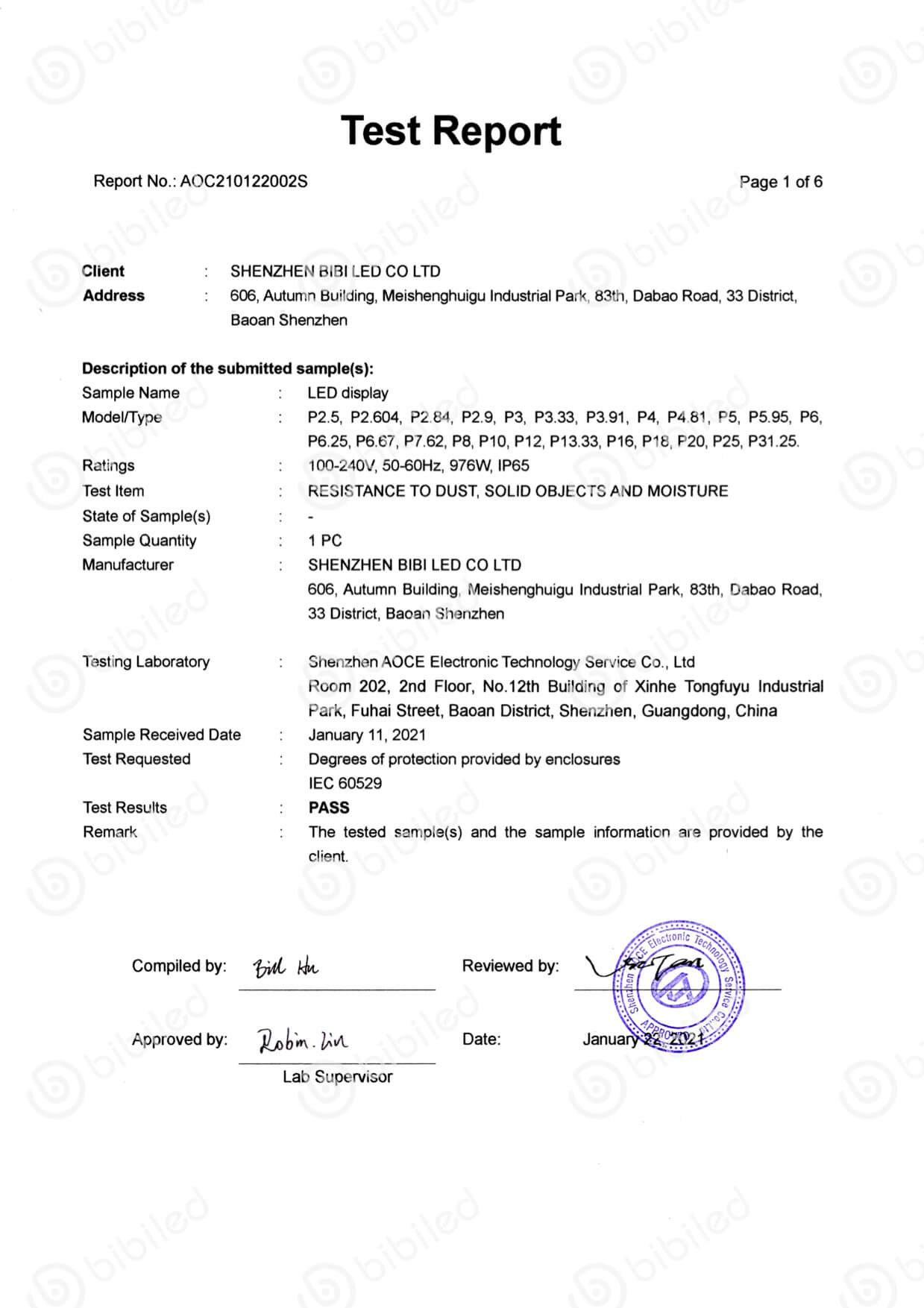介绍
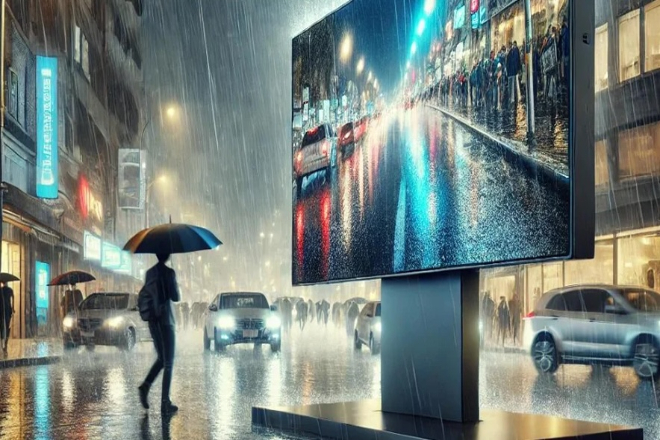
雨季已经成为许多用户的头疼问题。一些用户会发现他们的 LED显示屏 在雨季经常发生故障。
要么是灯珠不亮,要么是电路板短路,要么是显示效果大大降低,为什么会这样呢?
本文将带您了解雨季环境下LED显示屏频繁出现故障的原因,并给出切实可行的预防和解决措施,助您轻松应对雨季的挑战。
目录
1、梅雨季节环境因素对LED显示屏的影响
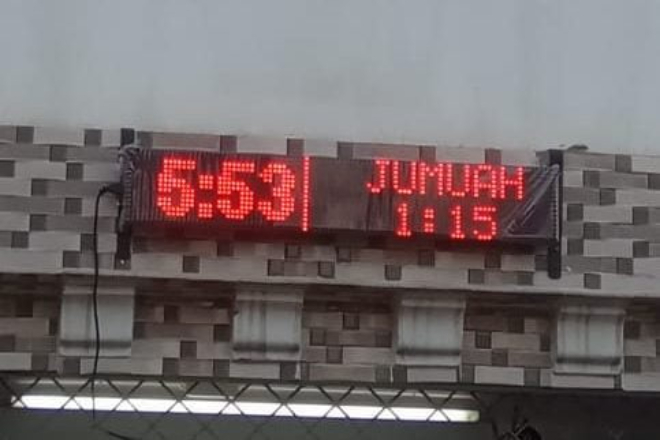
1.1).对灯珠的影响
梅雨季节空气潮湿,就像空气中有很多小水滴,这些水滴很容易在LED显示屏表面和内部凝结成水。
灯珠是显示屏的关键部件,一旦受潮,发光效率就会“打折扣”,变得不那么亮。
而且潮湿的环境还会加速灯珠内电子元件的老化,缩短其寿命。
更糟糕的是,如果水滴渗入到灯珠的电路中,很容易导致灯珠短路,直接“报废”。
1.2).对电路板的影响
电路板是显示屏的“大脑”,上面布满了各种电子元器件和导电电路。
在潮湿的环境下,电路板就像被放在“潮湿的空气”中,金属导线会加速氧化,就像铁生锈一样,导电性能变差。
电路板的绝缘材料也会受到湿气的“侵蚀”,绝缘性能下降,容易发生短路。
另外,电路板上的焊点、元器件也会因为潮湿而出现松动、损坏的情况,就像东西在潮湿的环境下更容易坏一样,从而导致显示屏出现各种故障,比如突然不亮、显示不正常等。
2.1).对显示屏结构的影响
梅雨季节气温变化较大,显示屏箱体、电路板等部件材质不同,热胀冷缩程度也不同。
就像夏天热了,东西会膨胀;冬天冷了,东西会收缩一样,气温变化的时候,显示屏的外壳就有可能变形、开裂。
例如,机柜外壳与电路板之间的连接可能会因膨胀和收缩不同而松动,影响显示屏的结构稳定性。
这就如同房屋的地基不稳固一样,显示屏的显示效果也会变差,甚至可能存在安全隐患。
2.2).对电子元器件性能的影响
显示屏的正常工作离不开各种电子元器件,比如电源模块中的电容、电阻等。
这些组件的性能也会受到温度变化的影响。
例如,当温度变化时,电容器内部的电解液就会“上火”,容量会下降,漏电流也会增大。
电阻器也会因温度的变化而改变其电阻值。
当这些元器件的参数发生变化时,显示屏的电源就会不稳定,可能会出现亮度不稳定、闪烁、或者部分区域不显示等问题。
此外,温度的变化也会使电子元件老化得更快,缩短其寿命。
3.1). 内部组件的物理损坏
如果雨水直接落在显示屏上,很容易通过外壳、通风口等缝隙渗入。
一旦雨水渗入,对于灯珠、电路板、电源模块等元器件来说,将是一场“灾难”。
灯珠遇水容易短路;电路板泡在水中,会加速氧化腐蚀。
电源模块的元器件也可能会被烧毁,如果这些元器件损坏,显示屏将无法正常工作。
3.2). 对散热和光学性能的影响
雨水中含有很多杂质和污染物,这些污垢会粘附在显示屏的表面或内部。
它们会堵塞散热通道,使显示屏的散热效果变差,使内部温度升高。
当温度较高时,电子元件更容易损坏。
而且这些杂质还会使显示屏看起来模糊,光线受到遮挡,亮度和对比度下降,显示效果大大降低。
2、LED显示屏本身的不合格因素导致雨季故障频发

1). 防护等级不够
防护等级是显示屏的防尘、防水能力,以IP数字表示。
比如IP54只能防灰尘和少量水溅,适合室内使用,如果在雨季放在室外,就无法承受了。
IP65就强大很多了,可以防喷水,适合户外使用,但是如果遇到大雨的话,还是会有些困难。
IP67更是强大,短时间浸泡在水中也没有问题,特别适合雨季户外使用。
但有些显示屏的防护等级设计并不到位,比如明明是为户外使用而设计的,却只达到了IP54。
一旦雨季来临,他们肯定无法承受。
有些显示屏虽然标有IP65或IP67,但实际上根本不符合该标准。
例如,柜体密封不严,通风孔保护不好,防水条长期使用后老化,成为雨水、湿气的“入口”。
就拿橱柜的密封条来说,如果密封条老化、变形或者安装不好,雨水就会从缝隙中渗入。
通风孔也是一样,如果防护网质量不好,或者没有防水膜,雨水也会从那里进来。
防水条如果长期暴露在外面,就容易老化、开裂,防水功能也就没有了。
这些小问题在雨季会给显示屏带来大麻烦。
2). 材质差
LED显示屏的灯珠、电路板、电源模块等元器件材质较差,在雨季容易损坏。
灯珠是显示屏发光的关键,如果质量差,受潮后很容易出现光衰(即亮度变暗)或者死灯(直接不亮)。
有些低质量的灯珠防水性能较差,一旦遇到潮湿的环境,内部电路就会短路。
一些不良厂家为了省钱,使用劣质灯珠,而这些灯珠在雨季特别容易坏。
电路板也一样,如果基板和铜镀层质量不好,就容易发生吸湿、氧化腐蚀等现象。
在潮湿的环境下,电路板的导电性能会变差,甚至发生短路或者断裂。
如果电源模块内的电解电容质量不好,当温度、湿度变化时很容易漏液,导致电源模块失效。
这些不良厂商为了降低成本,在材料采购、生产环节偷工减料。
他们使用劣质材料,减少工序,导致显示屏在雨季的可靠性大大降低。
所以在购买显示屏的时候一定要选择质量好的材料,找正规的厂家,这样在雨季的时候出现的问题就会少一些。
3).安装维护不到位
如果安装和维护过程中出现问题,显示屏在雨季也容易出现故障。
在安装的时候,如果位置选择不好,比如把显示屏安装在容易积水或者潮湿的地方,那么到了雨季,肯定会出现问题。
如果安装时没有按照规范进行,比如保护壳密封不好,线路连接松动,雨水和湿气就会趁机进入。
保养也很重要,如果显示屏长期不清洁,表面和内部就会积聚灰尘,散热和防护性能就会变差。
灰尘堵塞散热通道,内部温度升高,电子元件更容易损坏。
防水条、密封垫等防护部件损坏如果不及时更换,雨水也会从那里渗入。
如果不定期进行防水防潮检测和维护,潜在的问题就无法被发现,当雨季到来时,显示屏很容易出现大麻烦。
总之,要减少显示屏在雨季的故障,设计时必须正确选择防护等级,材料质量必须达标,安装和维护也不能马虎。
3、雨季LED显示屏损坏的预防及解决措施
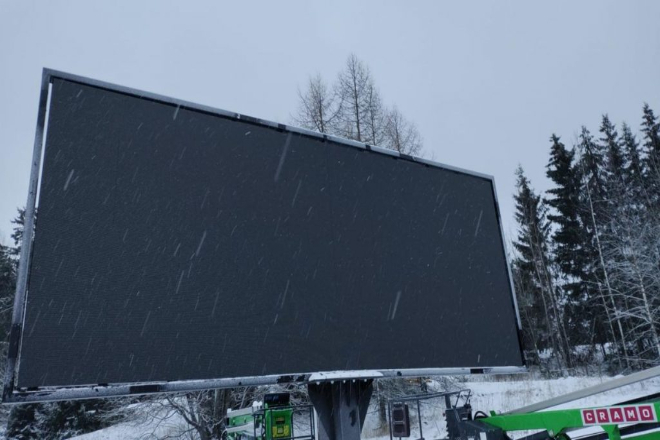
1). 提高防护等级
简单来说,就是要给显示屏选择合适的“防护服”。如果显示屏放在室内,IP54的防护等级可能就足够了,因为室内温度一般不会太潮湿。
但如果放在室外,特别是雨水较大的地方,至少也要选择IP65,如果经常遇到大雨,那就必须使用IP67,这样才能抵御雨水的“侵袭”。
在制造显示屏的时候,一定要使用好的材料,比如密封条,一定要选择质量好的,这样才不容易老化、变形,而且能有效的阻挡雨水和湿气。
盒子的设计也很重要,缝隙越小越好,越紧越好,雨水就没有机会进去。
通风孔也不能马虎,一定要加一层防水透气膜,这样才能散热、防雨。
2). 选择优质材料
购买显示屏不能只看价格,关键部件的材质质量一定要达标。
比如灯珠一定要选择防水性能好的,这样受潮之后才不容易破碎。
电路板也一样,必须采用耐腐蚀、防潮的材质,才不会在潮湿的环境下轻易被氧化。
电源模块中的电容等元器件必须选用抗老化能力强的元器件,否则当温度、湿度变化时,很容易损坏。
了解材料的性能也很重要,比如有的材料特别防潮,有的材料特别耐腐蚀。
如果选择合适的材料,显示屏在雨季的可靠性可以大大提高。简而言之,不要贪图便宜,质量才是关键。
3). 标准化安装,强化维护
安装显示屏的时候一定要找专业人员来做,而且位置也很关键。
尽量避开容易积水、潮湿的地方,比如低洼处或者靠近水源的地方。
安装时,保护壳必须密封良好,线路连接牢固,不能松动,否则雨水、湿气会趁机进入。
保养也很重要,定期清洁显示屏,清除所有灰尘,这样才能保持良好的散热和防护性能。
还要定期检查防水条、密封垫是否破损,如有破损应及时更换。
同时定期进行防水防潮测试,提前发现潜在问题并及时解决,可以大大降低雨季发生故障的概率。
4). 技术改进与创新
现在,有许多新技术、新材料可用。
例如,新型防水防潮涂层能够在显示器表面形成一层致密的保护膜,就像给显示器披上一件“雨衣”,能够有效防止雨水和湿气的侵入。
还有智能监控系统,可以实时监控显示屏的温度、湿度、电流等参数,如果发现异常。
例如,如果温度突然升高或者湿度超标,系统就会提前发出警告,提醒您可能出现的故障,以便及时采取措施,防止小问题变成大故障。
这些新技术可以为LED显示屏在雨季的稳定运行提供很大的帮助。
4. 其他注意事项
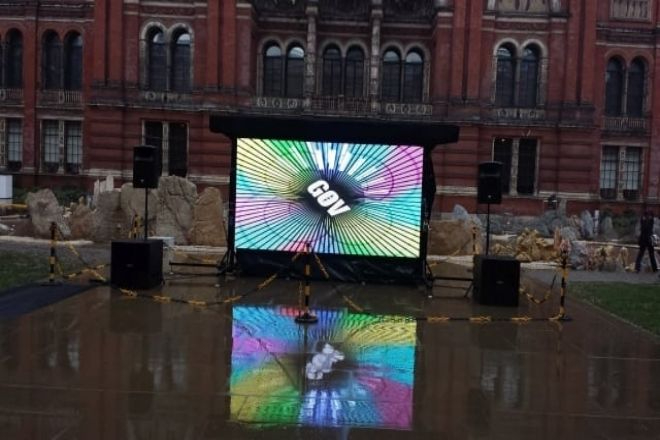
1). 电源保护
电源线就像是显示屏的“生命线”,如果被雨水浸泡,很容易出现问题。
因此,必须使用防水电源线,或者在接口上套上防水盖,就像穿上“雨衣”来挡雨一样。
另外,供电系统中最好安装漏电保护器。
一旦发生漏电,能立即切断电源,防止设备烧毁,保护人身安全。
这些小措施虽然简单,但在关键时刻却能救命。
2). 散热管理
散热很重要,尤其是雨季,最好给室外展示柜排水,不然雨水会积聚在里面,就像泡在水里一样,很容易破裂。
此外,散热风扇还必须防水,否则潮湿的空气会损坏风扇或从外面带入湿气。
如果风扇坏了,显示器就很容易“发热”,所以选择防水防潮的风扇很重要。
3). 环境监测
在显示器旁边安装一个湿度传感器,就像拥有一个“天气预报员”,可以随时了解周围的湿度。如果湿度过高,请快速关闭显示器,或使用除湿机去除湿气。
温度也很重要,太热或太冷都不好。
安装温度传感器,随时检测温度,这样可以提前发现问题,防止显示器在恶劣环境下“生病”。
4). 应急措施
雨季天气变化很快,随时可能停电。
这时候准备一台UPS(不间断电源)就非常有用了,它可以在停电时给显示屏“延寿”,防止突然断电烧坏设备。
另外,最好准备一个简单的应急计划,比如如何快速检查显示屏是否进水,以及在大雨的情况下如何处理突发故障。
这样,当你遇到问题时,你就能冷静地解决它。
5).定期检查
定期检查显示屏就像给它做一次“体检”。检查是否有裂纹、变形或密封不良。
这些小问题如果不及时处理,可能会变成大麻烦。
除了外观之外,还要检查内部是否有积水或潮湿的迹象。
如果发现问题,应立即使用干燥剂或除湿设备进行处理。
定期检查虽然麻烦一些,但可以提前发现问题,避免设备损坏。
6). 用户培训
如果显示屏由多人使用,请务必对操作人员进行简单的培训。
比如告诉他们雨季的时候不要在潮湿的环境中频繁开关机器,因为这样很容易损坏设备。
另外提醒大家不要在显示屏附近溅水,也不要用手触摸湿润的显示屏。
如果操作规范的话,显示屏使用的也会比较长久,而且比较安全。
5、BIBILED户外LED显示屏防水效果
六,结论
虽然梅雨季节对于LED显示屏来说是一道“难关”,但只要掌握正确的方法,就可以轻松化解危机。
希望本文的分析和建议能够给您带来启发,帮助您在雨季保持显示屏稳定运行,达到最佳使用效果。
最后,如果您想了解更多关于LED显示屏的知识, 请与我们联系.

